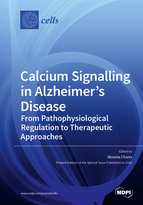Calcium Signalling in Alzheimer’s Disease: From Pathophysiological Regulation to Therapeutic Approaches
A special issue of Cells (ISSN 2073-4409). This special issue belongs to the section "Cellular Pathology".
Deadline for manuscript submissions: closed (31 August 2020) | Viewed by 29939
Special Issue Editor
Interests: mitochondria; mitophagy; endoplasmic reticulum stress; calcium signaling; Alzheimer’s disease
Special Issues, Collections and Topics in MDPI journals
Special Issue Information
Dear Colleagues,
Alzheimer’s disease (AD) is the most commonly known neurodegenerative disorder, causing dementia. AD is a proteinopathy characterized by the accumulation of extracellular amyloid beta aggregates and intracellular hyperphosphorylated Tau protein contributing to neuronal dysfunction and demise. Cellular calcium signaling regulates several facets of neuronal physiology orchestrating cell life and death mechanisms and most key events in between. In recent decades, several studies have reported calcium dysregulation in AD, affecting different cellular compartments, such as mitochondria, endoplasmic reticulum, lysosomes, and several microdomains within the plasma membrane, and occurring through a broad intervention of several calcium signaling “tool-kits” (receptors, channels, binding proteins, etc.). The obtained results depict calcium signaling dysregulation as a common proximal cause of dysfunctional neurons and also glial supporting cells. The objective of this Special Issue is to gather the newest results and advances on: i) calcium signaling deregulation mechanisms in AD, ii) how they are linked to other players involved in AD pathogenesis, and iii) potential therapeutic approaches to correct calcium alterations to treat AD.
Dr. Mounia Chami
Guest Editor
Manuscript Submission Information
Manuscripts should be submitted online at www.mdpi.com by registering and logging in to this website. Once you are registered, click here to go to the submission form. Manuscripts can be submitted until the deadline. All submissions that pass pre-check are peer-reviewed. Accepted papers will be published continuously in the journal (as soon as accepted) and will be listed together on the special issue website. Research articles, review articles as well as short communications are invited. For planned papers, a title and short abstract (about 100 words) can be sent to the Editorial Office for announcement on this website.
Submitted manuscripts should not have been published previously, nor be under consideration for publication elsewhere (except conference proceedings papers). All manuscripts are thoroughly refereed through a single-blind peer-review process. A guide for authors and other relevant information for submission of manuscripts is available on the Instructions for Authors page. Cells is an international peer-reviewed open access semimonthly journal published by MDPI.
Please visit the Instructions for Authors page before submitting a manuscript. The Article Processing Charge (APC) for publication in this open access journal is 2700 CHF (Swiss Francs). Submitted papers should be well formatted and use good English. Authors may use MDPI's English editing service prior to publication or during author revisions.
Keywords
- Alzheimer’s disease
- aging
- amyloid β
- amyloid precursor protein
- calcium
- Ca2+ signaling
- Ca2+ channels
- Ca2+ receptors
- Ca2+ binding proteins
- endoplasmic reticulum
- mitochondria
- lysosomes
- synaptic plasticity
- IP3R
- RyR
- SOCE
- presennilin
- glutamate receptors
- AMPA receptors
- neurons
- astrocytes
- microglia
- neurodegeneration







